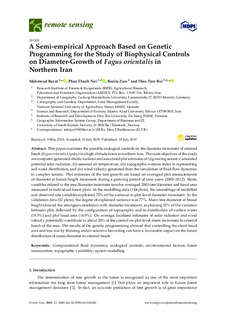| dc.contributor.author | Bayat, Mahmoud | |
| dc.contributor.author | Noi, Phan Thanh | |
| dc.contributor.author | Zare, Rozita | |
| dc.contributor.author | Tien Bui, Dieu | |
| dc.date.accessioned | 2019-11-14T11:42:36Z | |
| dc.date.available | 2019-11-14T11:42:36Z | |
| dc.date.created | 2019-07-19T13:30:22Z | |
| dc.date.issued | 2019 | |
| dc.identifier.citation | Remote Sensing. 2019, 11 (14). | nb_NO |
| dc.identifier.issn | 2072-4292 | |
| dc.identifier.uri | http://hdl.handle.net/11250/2628515 | |
| dc.description | Licensee MDPI, Basel, Switzerland. This article is an open access article distributed under the terms and conditions of the Creative Commons Attribution (CC BY) license | nb_NO |
| dc.description.abstract | This paper examines the possible ecological controls on the diameter increment of oriental beech (Fagus orientalis Lipsky) in a high altitude forest in northern Iran. The main objectives of the study are computer-generated abiotic surfaces and associated plot estimates of (i) growing-season-cumulated potential solar radiation, (ii) seasonal air temperature, (iii) topographic wetness index in representing soil water distribution, and (iv) wind velocity generated from the simulation of fluid-flow dynamics in complex terrain. Plot estimates of the tree growth are based on averaged plot measurements of diameter at breast height increment during a growing period of nine years (2003–2012). Biotic variables related to the tree diameter increment involve averaged 2003 tree diameter and basal area measured in individual forest plots. In the modelling data (144 plots), the assemblage of modelled and observed site variables explained 75% of the variance in plot-level diameter increment. In the validation data (32 plots), the degree of explained variance was 77%. Mean tree diameter at breast height showed the strongest correlation with diameter increment, explaining 32% of the variation between-plot, followed by the configuration of topography and re-distribution of surface water (19.5%) and plot basal area (16.9%). On average, localised estimates of solar radiation and wind velocity potentially contribute to about 20% of the control on plot-level mean increment in oriental beech of the area. The results of the genetic programming showed that controlling the stand basal area and tree size by thinning and/or selective harvesting can have a favourable impact on the future distribution of mean diameter in oriental beech. | nb_NO |
| dc.language.iso | eng | nb_NO |
| dc.rights | Navngivelse 4.0 Internasjonal | * |
| dc.rights.uri | http://creativecommons.org/licenses/by/4.0/deed.no | * |
| dc.title | A Semi-empirical Approach Based on Genetic Programming for the Study of Biophysical Controls on Diameter-Growth of Fagus orientalis in Northern Iran | nb_NO |
| dc.type | Journal article | nb_NO |
| dc.type | Peer reviewed | nb_NO |
| dc.description.version | publishedVersion | nb_NO |
| dc.rights.holder | © 2019 by the authors. | nb_NO |
| dc.source.pagenumber | 18 | nb_NO |
| dc.source.volume | 11 | nb_NO |
| dc.source.journal | Remote Sensing | nb_NO |
| dc.source.issue | 14 | nb_NO |
| dc.identifier.doi | 10.3390/rs11141680 | |
| dc.identifier.cristin | 1712126 | |
| cristin.unitcode | 222,57,1,0 | |
| cristin.unitname | Institutt for økonomi og IT | |
| cristin.ispublished | true | |
| cristin.fulltext | original | |
| cristin.qualitycode | 1 | |

